Baroda-based artist Indrapramit Roy on what makes Abanindranath Tagore’s 1930 watercolour Hunchback of the Fishbone essential viewing
Making art accessible to children, one artist and one artwork at a time

ARTWORK: Hunchback of the Fishbone
ARTIST: Abanindranath Tagore
WHERE CAN IT BE VIEWED: Victoria Memorial Hall, Kolkata
Does the name of Abanindranath Tagore ring a bell? He was poet Rabindranath Tagore’s nephew. Abanindranath was the initiator of the Bengal School of art that started at the beginning of the 20 th century and spread to the rest of India. In 1930, Abanindranath painted a set of 45 paintings based on stories from the Thousand and One Arabian Nights. These stories came from Persia (now Iran and Iraq). You are familiar with Alibaba and Forty Thieves or Aladdin and his Magic Lamp. This painting is based on a story called The Hunchback of the Fishbone.
The story goes like this – in the city of Basra lived a tailor and his wife. One day, they met a hunchbacked man who they found very entertaining. They invited him over for a meal and offered him a large fish to eat. Unfortunately, a bone stuck in the hunchback’s throat and he choked. When the tailor couple failed to revive him, they panicked thinking him to be dead. They passed the
body on to their neighbour. The neighbour passed it on to another person and so on until all were caught and tried for murder. Just when the Kazi (the judge) passed a guilty verdict, the hunchback revived and happily all were spared.
Now let‘s take a look at the painting and see how Abanindranath plays with the story in his retelling. Like many Indian miniature paintings, he divides the space in horizontal bands. At the lowest band is a bearded man in a red turban in a room and, in another, a man with a topi staring at the cat on the roof. These are the neighbours of the story based on people the artist saw around him. Look up to the left — an elderly Muslim tailor and his young wife are trying to revive the enormous hunchback. On the floor lies the plate with the fishbone, indicating the unfortunate meal. In the alcove behind sits a modern sewing machine.
To the right of this scene, we spot a prominent signboard: ‘Kerr Tagore & Co’. This has a history. The great grandfather of Abanindranath, Prince Dwarkanath Tagore started the actual Indo-British joint venture company in 1834. Dwarkanath was one of the richest man of his time.
Above the signboard, spot three people seated around a table having dinner. A uniformed khansama serving an elderly European couple with slight hunches and their host, a bespectacled Indian wearing a white cap. That is the painter Abanindranath himself!
The painter has inserted himself in the painting in the guise of the host entertaining two guests and created a parallel narrative to the main story!
Further up, the Union Jack of the Imperial British Government flies in the dark night. The flag roots the story of medieval Persia firmly in early 20th C. Calcutta — the crown of the British Empire, the city that Abanindranath lived in and loved.
Associate professor at the painting department at Faculty of Fine Arts, MS University, Baroda, Indrapramit Roy’s works depict a range of themes, from his immediate surroundings to the numerous travels, memories and utopian cityscapes. Working in a variety of media, from print-making to painting, Roy has also illustrated several children’s books, including The Very Hungry Lion (1995) and The Bacchae (2004).
For all the latest Parenting News, download Indian Express App.